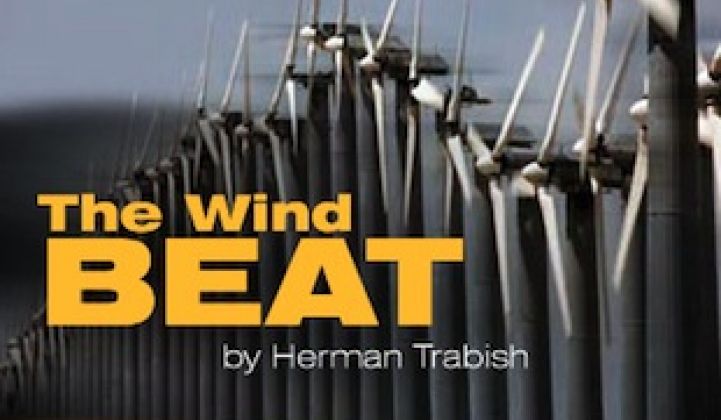With a Q4 installed capacity of 8,380 megawatts, the U.S. wind industry brought its 2012 total to 13,124 megawatts, shattering its 2009 record by 3,000 megawatts. With its record year, U.S. wind became the first renewable energy to lead the nation in annual new generation capacity, ahead of traditional electricity sources like natural gas, coal and nuclear, according to the American Wind Energy Association (AWEA) Q4 2012 report.
Wind power was 42 percent of all new U.S. generation capacity built in 2012. Total new renewable capacity was over 55 percent of the nation’s build.
In Texas, which once again led the U.S. in cumulative, annual, and Q4 installed capacity, the Electric Reliability Council (ERCOT) released a report with some startling conclusions. ERCOT’s newest cost and output numbers showed wind and solar to be more competitive than natural gas over the next twenty years and serving to drive electricity market prices lower.
With its Competitive Renewable Energy Zone (CREZ) transmission initiative about to be completed, this sets Texas up for a huge renewables future if its legislators and regulators choose to continue backing them.
U.S. wind was driven last year by the threat its production tax credit (PTC) might not be renewed at its December 31, 2012 expiration, as well as by a strong pipeline built up during the preceding three years in which the PTC did not require renewal by Congress. The industry leveraged $25 billion in private investment as it brought its total installed capacity to 60,007 megawatts, which could power almost 15 million U.S. homes.

Most indicative of where the big 2012 numbers came from, the industry upped its list of utility owners/buyers from 42 in 2011 to 66 last year, had eighteen new industrial customers and added eleven schools and universities and eight towns/cities.
Indicative of where the big Q4 numbers came from, Duke Energy Renewables (NYSE:DUK) brought in its 402-megawatt Los Vientos 1 and 2 in Texas; Iberdrola Renewables brought in 265.5 megawatts with three projects (California: 189 megawatts, Massachusetts: 28.5 megawatts, New Hampshire: 48 megawatts); and Apex Wind Energy brought in a 300-megawatt project in Oklahoma.
With the PTC restored for a year by Congress and a language change in it that will allow developers to get the $0.022 per kilowatt-hour credit if they can get the project into construction by the end of 2013 (the previous PTC law required the project to be in production to qualify), developers have once again begun negotiating deals, said AWEA Interim CEO Rob Gramlich, and announcements are expected soon.
In the interim, the industry is turning to innovation and experimentation with big ideas.
In the innovation category, Siemens (NYSE:SI) introduced a new, 4-megawatt offshore turbine with a remarkable 130-meter blade-tip-to-blade-tip rotor diameter. It is an advance on Siemens’ 3.6-megawatt offshore machine that has been installed in more ocean projects than any other turbine.

General Electric (NYSE:GE) announced a new 2.5-megawatt machine with a 120-meter rotor diameter that is an advance on its 1.6-megawatt turbine specialized to low wind regions. GE calls it the first "brilliant" turbine because of a 25 percent increase in efficiency that GE says will increase power output by 15 percent. The turbine’s onboard connections to what GE calls the industrial internet assimilate “tens of thousands of data points” and “advanced forecasting algorithms” to maximize the harvest of even low-speed winds.
In the experimentation category, a Belgian government official has revived a Dutch idea to build a wind storage atoll in the North Sea. A land mass with a raised central basin would be engineered in the sea along Belgium’s coast. Off-peak North Sea wind power would be used to pump sea water upward to the basin. On demand, it could flow down through an electricity-generating turbine and then back to the sea.
The atoll would be built on the relatively shallow North Sea continental shelf. The cost of the engineering challenge is the issue, experts say. If the engineering is possible, the pumped hydro concept might work – if using salt water doesn’t create problems with the turbine.
On land, Clean Wind Energy (CWE) has revived the downdraft wind tower concept with budding potential success. The Department of Energy selected CWE’s technology to compete in the Future Energy Pitching Event at the ARPA-E Energy Innovation Summit.
Recyclable water would cool hot air at the top of the 2,250-foot-tall tower, creating a downdraft that would drive a conventional wind turbine at the base that would generate electricity. For a proposed project in Arizona, CWE estimates a nameplate capacity of 1,000 megawatts, a capacity factor of 70 percent, and a parasitic load of 17 percent, leaving an output of approximately 600 megawatts.
Two wind industry veterans at NREL’s Wind Technology Center independently told GTM that because the concept has been around since the 1980s but was never thought to be cost-effective, they welcomed the chance for the technology to prove itself or to finally be dismissed.



